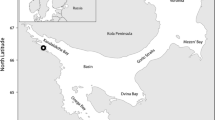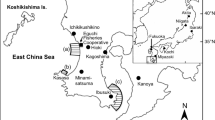Abstract
The brittle star Ophiura sarsii with a disc diameter (DD) of less than 9 mm is an important prey item for flathead flounder Hippoglossoides dubius in Funka Bay. To establish an age-determination technique and estimate the growth equation for Ophiura sarsii sarsii (a dominant sub-species of O. sarsii in Funka Bay), we observed ridges on the surface of the arm ossicles. Specimens were collected using a sledge net, their DD measured, and the first arm ossicles examined from scanning electron microscopy images. Because the outermost ridges were formed from November to March, ridges were identified as yearly rings (annuli). The maximum age was 16.83 years (16.46-mm DD), and the largest sized individual was 22.19-mm DD (13.75 years). The best growth equation between DD and age (t) was given by Richard’s model using a minimum Akaike’s information criterion and growth rate comparison: DDt= 24.02 × {1 − 1.70 × exp[− 0.067 × (t + 8.25)]}−1/(−1.70). Small-sized (< 9-mm DD) and large-sized (ca. 15-mm DD) cohorts were composed of multi-year classes, and estimated growth rates from cohort progressions were 2.25 mm/year and 0.98 mm/year, respectively. We presumed that the large-sized cohort could be explained by a high survival rate and slow growth rate after the age of 5 or 6 years.









Similar content being viewed by others
References
Aizawa Y, Takiguchi N (1999) Consideration of the methods for estimating the age-composition from the length frequency data with MS-Excel. Bull Jpn Soc Fish Oceanogr 63:205–214 (in Japanese)
Beamish RJ, Fournier DA (1981) A method for comparing the precision of a set of age determinations. Can J Fish Aquat Sci 38:982–983
Bernstein BB, Williams BE, Mann KH (1981) The role of behavioral responses to predators in modifying urchins’ (Strongylocentrous droebachiensis) destructive grazing and seasonal foraging patterns. Mar Biol 63:39–49
Campana SE (2001) Accuracy, precision and quality control in age determination, including a review of the use and abuse of age validation methods. J Fish Biol 59:197–242
Campana SE, Annand MC, McMillan JI (1995) Graphical and statistical methods for determining the consistency of age determinations. Trans Am Fish Soc 124:131–138
Chang WYB (1982) A statistical method for evaluating the reproducibility of age determination. Can J Fish Aquat Sci 39:1208–1210
Dahm C (1993) Growth production and ecological significance of Ophiura albida and O. ophiura (Echinodermata: Ophiuroidea) in the German Bight. Mar Biol 116:431–437
Dahm C, Brey T (1998) Determination of growth and age of slow growing brittle stars (Echinodermata: Ophiuroidea) from natural growth bands. J Mar Biol Assoc UK 78:941–951
Djakonov AM (1954) Ophiuroids of USSR seas. The Zoological Institute of the Academy Science of the USSR, Moscow (translated from Russian by Israel Program for scientific translations)
Fujita T, Ohta S (1990) Size structure of dense population of the brittle star Ophiura sarsii (Ophiuroidea: Echinodermata) in the bathyal zone around Japan. Mar Ecol Prog Ser 64:113–122
Gage JD (1990) Skeletal growth bands in brittle stars: microstructure and significance as age markers. J Mar Biol Assoc UK 70:209–224
Gage JD (2003) Growth and production of Ophiocten gracilis (Ophiuroidea: Echinodermata) on the Scottish continental slope. Mar Biol 143:85–97
Gage JD, Anderson RM, Tyler PA, Chapman R, Dolan E (2004) Growth, reproduction and possible recruitment variability in the abyssal brittle star Ophiocten hastatum (Ophiuroidea: Echinodermata) in the NE Atlantic. Deep Sea Res I 51:849–864
Hirota Y, Tominaga S, Ueharako T, Kodama K, Sadayuki T, Tanaka M, Yoshida S, Kojima H, Okiishi Y (1989) Spatial distribution of mysids in coastal areas in the Japan Sea. Cont Fish Res Jpn Sea Block 15:43–57 (in Japanese)
Inagaki Y, Takatsu T, Ashida Y, Takahashi T (2012) Annual changes in macrobenthos abundance in Funka Bay, Japan. Fish Sci 18:647–659
Inagaki Y, Takatsu T, Kimura M, Kano Y, Takahashi T, Kamei Y, Kobayashi N, Maeda T (2014) Improved growth of flathead flounder Hippoglossoides dubius in hypoxic waters in Funka Bay, Japan. Fish Sci 80:725–734
Iwakawa K, Takahashi T, Takatsu T, Inagaki Y, Nakatani T, Maeda T (2013) Growth pattern of flathead flounder Hippoglossoides dubius in Funka Bay, Hokkaido, Japan. Nippon Suisan Gakkaishi 79:10–19 (in Japanese with English abstract)
Keats DW (1991) American plaice, Hippoglossoides platessoides (Fabricius), predation on green sea urchin Strongylocentrous droebachiensis (OF Müller) in eastern Newfoundland. J Fish Biol 38:67–72
Kimura M, Takahashi T, Takatsu T, Nakatani T, Maeda T (2004) Effects of hypoxia on principal prey and growth of flathead flounder Hippoglossoides dubius in Funka Bay, Japan. Fish Sci 70:537–545
Kogure Y (1999) Echinoderms from the lower-sublittoral zone on the north-western coasts of Sado Island, the Japan Sea. Bull Jpn Sea Natl Fish Res Inst 49:57–67 (in Japanese with English abstract)
Kogure Y (2002) Identification key of major Ophiuroidea in the Sea of Japan. Renraku News of Japan Sea Natl Fish Res Inst 398:1–6 (in Japanese)
Kogure Y, Hayashi I (1998) Bathymetric distribution pattern of echinoderms in the Sado Strait, the Japan Sea. Bull Jpn Sea Natl Fish Res Inst 48:1–16
Maita Y (1998) On the hypoxic events during summer in Funka Bay, Hokkaido. In: The Hokusui Society Foundation (ed) Suisan gakujutsu kenkyuu kairyou hojo jigyou houkoku. The Hokusui Society Foundation, Sapporo, pp 31–44 (in Japanese)
Maita Y, Yanada M, Kudo I, Lee CW, Kuribayashi T, Inoue J, Morishita H (1999) Study on demersal fishery resources and ocean environment in Funka Bay. In: The Hokusui Society Foundation (ed) Suisan gakujutsu kenkyuu kairyou hojo jigyou houkoku. The Hokusui Society Foundation, Sapporo, pp 34–41 (in Japanese)
Ohmura T (2007) Spatial distribution patterns and feeding ecology of kichiji rockfish Sebastolobus macrochir on the continental slope off the Pacific coast, Hokkaido. PhD dissertation, Hokkaido University, Hakodate (in Japanese)
Ohtani K, Kido K (1980) Oceanography structure in Funka Bay. Mem Fac Fish Hokkaido Univ 31:84–114 (in Japanese with English abstract)
Packer DB, Watling L, Langton RW (1994) The population structure of the brittle star Ophiura sarsi Lütken in the Gulf of Maine and its trophic relationship to American plaice (Hippoglossoides platessoides Fabricius). J Exp Mar Biol Ecol 179:207–222
Ravelo AM, Konar B, Bluhm B, Iken K (2017) Growth and production of the brittle stars Ophiura sarsii and Ophiocten sericeum (Echinodermata: Ophiuroidea). Cont Shelf Res 139:9–20
Sakamoto Y, Ishiguro M, Kitagawa G (1983) Instructions in the AIC use. In: Information statistics (The lecture of information science A∙5∙4), Kyouritsu Shuppan, Tokyo, pp 63–64 (in Japanese)
Tyler PA (1980) Deep-sea ophiuroids. Oceanogr Mar Biol Annu Rev 18:125–153
Warner GF (1982) Food and feeding mechanisms: Ophiuroidea. In: Jangoux M, Lawrence JM (eds) Echinoderm nutrition. Balkema, Rotterdam, pp 161–184
Yokoyama S (1992) Ecological study on distribution and feeding of Hippoglossoides dubius in Funka Bay and its offshore waters, Hokkaido. PhD dissertation, Hokkaido University, Hakodate (in Japanese)
Acknowledgements
We would like to thank Associate Professor T. Nakatani for his insightful comments and Associate Professor H. Kudo for supporting our SEM work. We also thank Captain K. Kamei and the crew of the training ship Ushio-maru and students of the Graduate School of Fisheries Sciences and Faculty of Fisheries, Hokkaido University. We thank two anonymous reviewers and an editor for their insightful suggestions. This study was supported by the Hokusui Society Foundation, Sapporo, and the Japan Society for the Promotion of Science (KAKENHI grant nos 25450269, 16K07834).
Author information
Authors and Affiliations
Corresponding author
Additional information
Publisher's Note
Springer Nature remains neutral with regard to jurisdictional claims in published maps and institutional affiliations.
Rights and permissions
About this article
Cite this article
Orino, K., Ishigane, K., Suzuki, K. et al. Growth of the brittle star Ophiura sarsii sarsii in Funka Bay, Hokkaido, Japan. Fish Sci 85, 705–716 (2019). https://doi.org/10.1007/s12562-019-01323-1
Received:
Accepted:
Published:
Issue Date:
DOI: https://doi.org/10.1007/s12562-019-01323-1




